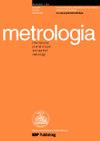通过 NIST 和 PTB 的激光功率校准来校准引力波观测站全球网络
IF 2.1
3区 工程技术
Q2 INSTRUMENTS & INSTRUMENTATION
引用次数: 0
摘要
目前的引力波观测站依靠光子校准器(Pcals),利用激光辐射压力产生位移靶标,用于校准探测器的输出信号。减少校准的不确定性可以从探测到的信号中优化提取天体物理信息,如源距离和天空位置。在 2023 年 5 月 24 日开始的 O4 观测运行中,全球引力波探测器网络正在采用一种新的校准方案,其转移标准由美国国家标准与技术研究院(NIST)和德国联邦物理技术研究院(PTB)共同校准。这些转移标准将在观测站和计量研究所之间循环使用,以提供可追溯到国际单位制(SI)的激光功率校准,并能够评估和减少观测站网络的相对校准误差。激光干涉引力波天文台(LIGO)项目和室女座项目目前正在参与新的校准计划。大规模低温引力波望远镜项目(KAGRA)预计将于 2024 年加入,印度的 LIGO Aundha 天文台(LAO)也将随后加入。在实施这一新计划之前,进行了 NIST-PTB 双边比较。报告了这次比较的结果,其不确定性大大低于以前的研究。我们还介绍了功率传感器校准的转移,包括详细的不确定性估计,从 NIST 和 PTB 校准的转移标准到在干涉仪端站连续运行的传感器。最后,我们讨论了正在为 O4 观测运行进行的 Pcal 诱导位移靶标校准。实现的综合标准不确定性水平低至 0.3%,有助于以亚百分精度校准干涉仪输出信号。本文章由计算机程序翻译,如有差异,请以英文原文为准。
Calibrating the global network of gravitational wave observatories via laser power calibration at NIST and PTB
Current gravitational wave observatories rely on Photon Calibrators (Pcals) that use laser radiation pressure to generate displacement fiducials used to calibrate detector output signals. Reducing calibration uncertainty enables optimal extraction of astrophysical information such as source distance and sky position from detected signals. For the ongoing O4 observation run that started on May 24, 2023, the global gravitational wave detector network is employing a new calibration scheme with transfer standards calibrated at both the National Institute of Standards and Technology (NIST) and the Physikalisch-Technische Bundesanstalt (PTB). These transfer standards will circulate between the observatories and the metrology institutes to provide laser power calibration traceable to the International System of Units (SI) and enable assessment and reduction of relative calibration errors for the observatory network. The Laser Interferometer Gravitational-Wave Observatory (LIGO) project and the Virgo project are currently participating in the new calibration scheme. The Large-scale Cryogenic Gravitational-wave Telescope project (KAGRA) is expected to join in 2024, with the LIGO Aundha Observatory (LAO) in India joining later. Before implementing this new scheme, a NIST-PTB bilateral comparison was conducted. The results of this comparison, with significantly lower uncertainty than previous studies, are reported. We also describe the transfer of power sensor calibration, including detailed uncertainty estimates, from the transfer standards calibrated by NIST and PTB to the sensors operating continuously at the interferometer end stations. Finally, we discuss the ongoing calibration of Pcal-induced displacement fiducials for the O4 observing run. Achieved combined standard uncertainty levels as low as 0.3 % facilitate calibrating the interferometer output signals with sub-percent accuracy.
求助全文
通过发布文献求助,成功后即可免费获取论文全文。
去求助
来源期刊

Metrologia
工程技术-物理:应用
CiteScore
2.80
自引率
25.00%
发文量
137
审稿时长
12 months
期刊介绍:
Published 6 times per year, Metrologia covers the fundamentals of measurements, particularly those dealing with the seven base units of the International System of Units (metre, kilogram, second, ampere, kelvin, candela, mole) or proposals to replace them.
The journal also publishes papers that contribute to the solution of difficult measurement problems and improve the accuracy of derived units and constants that are of fundamental importance to physics.
In addition to regular papers, the journal publishes review articles, issues devoted to single topics of timely interest and occasional conference proceedings. Letters to the Editor and Short Communications (generally three pages or less) are also considered.
 求助内容:
求助内容: 应助结果提醒方式:
应助结果提醒方式:


